![[flag]](../images/x/xi.gif)
image by António Martins, 13 Feb 2005

Last modified: 2017-11-17 by antónio martins
Keywords: inca | quechua | kechua | qhishwa | aymara | aimara | tawanti suyu | pusinsuyu | rainbow flag | sullpu | taru | tawantinsuyupa aucaruna | snake | snakes: 2 | turtle | ruminahui | atahualpa | ahimsa |
Links: FOTW homepage |
search |
disclaimer and copyright |
write us |
mirrors
![[flag]](../images/x/xi.gif)
image by António Martins, 13 Feb 2005
See also:
External links:
The Inca Empire do not exist as people anymore, but the flag is
considered by the Peruvians as Inca flag. Quechua
was the language of the Inca and is still the most spoken Indian language
in Peru.
Jan Patrick Fischer, 10 Nov 2003
"Pusinsuyo" (in Aymara) = "Tawantin Suyu"
(in Quechua). It means "Four parts" and was
the autonym of the Inca Empire. Spelling variants range from
"-nsuyo" to "-suyu".
António Martins, 11 Jul 2004
Although sharing roughly the same territory
— the central south american highland —, Aymara however are
based mainly in Bolivia and Peru and extending shouthwards to Chile and
Argentina, while Quechua has a somewhat northern nucleous and spreads to
the north, to Ecuador and Colombia.
António Martins, 04 Jun 2000
The Indigenous banner is called
huipala with the
seven colors of the rainbow (symbolizing the
unity of indigenous peoples before the conquest). There are some basic
versions of the whipala. The whipala with stripes is called
the Tawantinsuyo flag, or the Inca flag, the inca nation flag, the
Quechua nation flag. The original flag is the
striped whipala, which was the coat of arms of the Inca.
The Rainbow flag (Wipahla) belongs to the Native Andean people of
Tahuantinsuyu for more than 500 years. Each color and its place in
the flag as the rainbow, have an own indigenous significance. (In
Ecuador they have also some variants.)
Laila Holtet (of
tawantinsuyu.com),
09 Jul 2001
I can report the use as both [rainbow] flags [striped and
checkered] and decorations of two types of Inca or
Tawantinsuyi flags. In Peru it is mainly the
retangular shaped, horizontally striped “rainbow” variety
(no white stripe), while in
Bolivia it is the square “chequered
rainbow” variety (Qullasuyu version).
Both types of these flags are also shown of flown along side the two
nations’ national flags.
Ralph Bartlett, 14 and 18 and 23 Aug 2005
According to
Peru.21,
18 January 2006, the celebration of the 471st anniversary of the
Spanish foundation of Lima by Francisco Pizarro shall include an
allegoric parade, flag hoisting, official sessions and a mass celebrated
in the Basilical Cathedral.Flags will be hoisted by the local municipal
authorities on the Parade Ground (Plaza de Armas). The Mayor of
Lima, Luis Castañeda Lossio, will hoist the national
flag; Regidor Walter Menchola will hoist lo propio with
the city pennant and Regidora Marcia
Montero will hoist the same with the Tahuantinsuyo banner.
Ivan Sache, 20 Jan 2006
The 1990 Flags of Non-Independent Peoples chart
[jcl90], shows as flag No. 82
(«Quechua Indians or Incas») the rainbow flag of Peru
Ralph Bartlett, 18 Aug 2005
Does this flag contain a white stripe, or a
second, lighter, blue stripe? There are reports for
both… Since both versions exist, are they just variants — or two
separate flags? Aparently they are variants, as no source mentions them
both — but are they “opponent” variants (i.e., defended
respectively by rival groups as the real Inca flag — cp.
Argentina and Greece),
or just irrelevant as such?
António Martins, 12 Oct 2004
The Peru Inca “rainbow” flag is horizontal stripes, from top
to bottom: red, orange, yellow, green, light blue, dark blue, and purple.
There is no white stripe.
Ralph Bartlett, 23 Aug 2005
In this
online
2005 photo
(context),
can be seen seven-stripped Twantinsuyu flags (both
bottom-blue and bottom-purple
designs).
António Martins, 24 Nov 2006
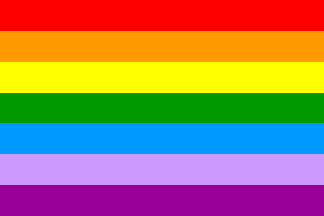
image by António Martins, 13 Feb 2005
The Inca flag, as shown on
this
photo and in
this
diagram, has no white stripe, but two purple stripes of different
shades.
António Martins, 12 Nov 2005
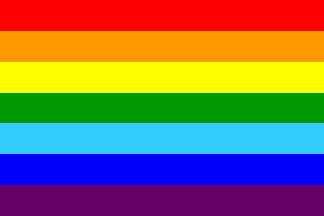
image by António Martins, 17 Sep 2003
Most used rainbow flag in Peru is the 7-stripes
flag with red - orange - yellow - green - light blue - dark blue - violet.
I saw this flag in Cuzco at a museum for peoples
art, at a wall painting in Cuzco about the peruvian history in the hand of
a indian fighting against spanish soldier and on an official building in
Lima. My Peruvian friend said, this flag is used by the indian population
of Peru, mainly Quechua (main people of the Inca empire) and some Aymara
at lake Titicaca (most of them are living in
Bolivia).
Jan Patrick Fischer, 25 Oct 2003
![[flag]](../images/x/xi_sq2b.gif)
image by António Martins, 03 Jun 2008
In Kara Chukiwanka’s article [qch9X]
this flag is presented as «Kurm
Wip’ala», or seven-colored
flag, one of the three flags of the Wiñaymarka
culture. It has seven horizontal stripes with two shades of blue
(therefore no white) and violet stripe at the bottom, but in
square shape. About this flag Kara
Chukiwanka’s article offers no solid information at all.
António Martins, 03 Jun 2008
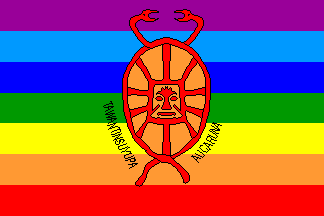
image by António Martins, 17 Sep 2003
The seven-stripe flag was created out of the flag, the indians used in
their rebellion 1570-1571.
Jan Patrick Fischer, 15 Mar 2001
I saw a reproduction of this flag in the museum of Fortress Real
Felipe in Callao. It was used by the leader of an Indian revolution in
18th century. It is violet - light blue - dark blue - light green - yellow
- orange - dark red, with a symbol, two snakes and the writting
"TAWANTINSUYUPA AUCARUNA".
Jan Patrick Fischer, 25 Oct 2003
Seven horizontal stripes of purple - light blue - medium blue - green -
yellow - orange - red, with a large central emblem consisting of a turtle
shell (?), orange lined red, it’s ridges and grooves composing a
human face in the center, encicled by two snakes; black lettering on each
side (over the green, yellow and orange stripes), slanted (or curved?)
reading in upper case "Tawantinsuyupa" (hoist side) and
"Aucaruna" (fly side). No info about the reverse.
António Martins, 02 Sep 2001
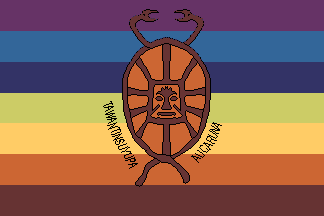
image by António Martins, 17 Sep 2003
The actual flag has darkened,
faded colors. Could the be the origin of wrongly
colored reports?
António Martins, 13 Aug 2004
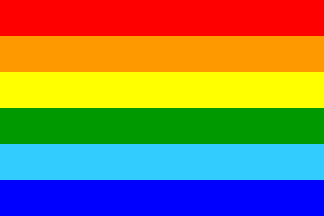
image by António Martins, 13 Aug 2004
On a postcard, showing the main square of Cuzco, I bought there, is
a six-stripes: flag red - yellow - green - light blue - dark blue. The
postcard seems to be older, maybe the former version?
Jan Patrick Fischer, 25 Oct 2003
At the top of the
main
page of the M.P.L.T. website, an
animated
image of a rainbow flag is shown (contrasting with the
7-stripe Inca used by this organization and
presented elsewhere in the same website, incl. on photos!). This comes
from a well-known source for Gay Pride rainbow
flag clipart; this phenomenon may occur frequently, as the gay flag is
worldwide available in many fomats, textile and electronic, and may be
seen a suitable surrogate for the real Inca seven-stripped flag, in
whichever variation.
António Martins, 13 Feb 2005
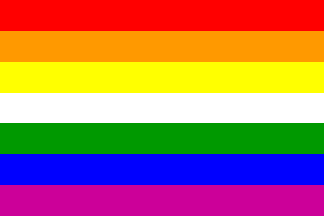
image by António Martins, 17 Sep 2003
The National Flag of Tawantinsuyu: seven
horizontal stripes: red, orange, yellow, white, green,
blue, and purple. The banner is called sullpu.
Jaume Ollé, 1997
The symbolism of the colors is red for earth, orange for society and
culture, yellow for energy, white for time, green for economy, blue for
space, and purple for policy.
Jaume Ollé, 06 Feb 2000
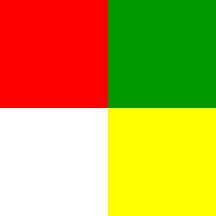
image by Kjell Roll Elgsaas, 14 Dec 1997
According to the Andean culture, the national flag is flown as part of
a pair. The pair of the national flag is
square and quartered red and green in the
top, and white and yellow in the bottom. Is called taru and
represents the equality of the four
territories.
Jaume Ollé, 1997
Are these are always used in pairs — carried by two persons (or
on both arms of the same person), or hoisted on two poles side-by-side? Or
two flags on the same pole? One above the other or at the same height?
What is the meaning of one of the flags if the pair used isolated? Are
both members of the pair of the same importance?
António Martins, 12 Feb 2000
We have heard that the Indigenous org. of Cuzco, Peru is thinking
about finding another flag to symbolize our native people, because
of the problem above of using the flag by the gays
community and the International Co-operative
Alliance [both using rainbow flags].
The gay community have not answered any email about this presented by
the United Indigenous Tribal Representatives, nor from
CONAIE, the indigenous leaders of
Cuzco or anyone else.
Laila Holtet
(of tawantinsuyu.com),
09 Jul 2001
In Kara Chukiwanka’s article [qch9X], three flags are presented thus: «la Cultura Wiñaymarka tuvo símbolos colectivos, enarbolados en todos los acontecimientos comunitarios »(, que son)« tres» (=«the Wiñaymarka culture had collective symbols, hoisted at all social events »(, which are)« three»):
There were also the black flags of Ruminahui (legendary
leader of the autonomous movement) and Atahualpa.
Laila Holtet (of
tawantinsuyu.com),
09 Jul 2001
In a gallery
of photos taken on Sept. 2003 in Machu Picchu, Peru, at
this Inca identity awareness
website, a
photo
showing a yellow flag with a red, blue and white device, captioned
«Oscar — Caravana Ahimsa».
António Martins, 05 Jul 2004
Ahimsa is supposedly a Hindu /
Jain / Buddhist
concept (“non-violence”, in which vegetarianism is often
included). Can’t possibly see what a concept from Asian religions
has to do with “Incas” in South America… But the
drawing in the middle does remind me (sort of) of Buddhist mandala
drawings.
João Madureira, 05 Jul 2004
Most about the
religious
information on the website is out of the traditional Indian (Inca)
religion in Peru, which is still in use beside and inside the Christian
religion there. This organization seems to provide traditional Indian
medecine including the legal use of coca leafs.
Jan Patrick Fischer, 05 Jul 2004
Anything below this line was not added by the editor of this page.